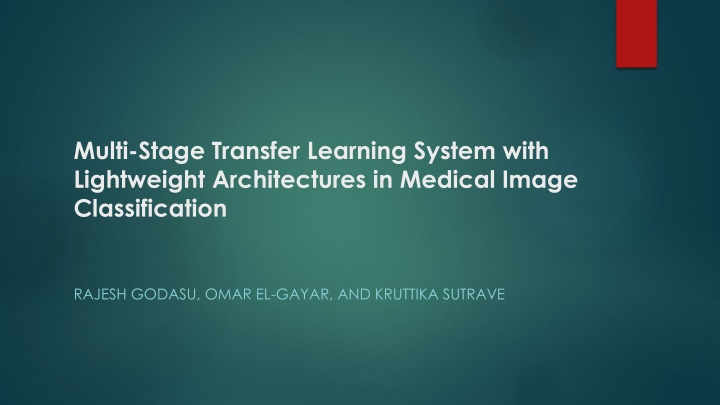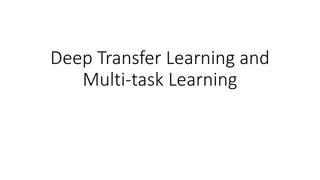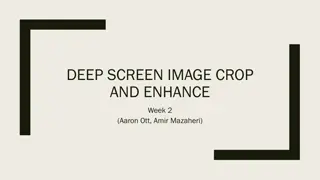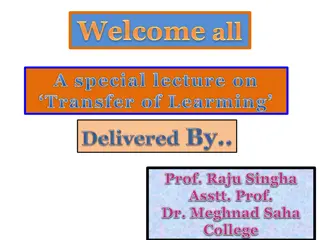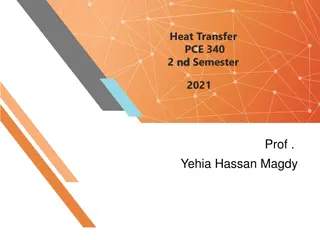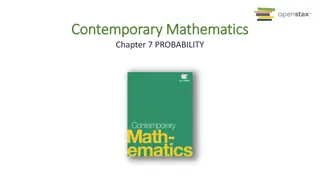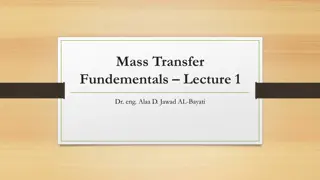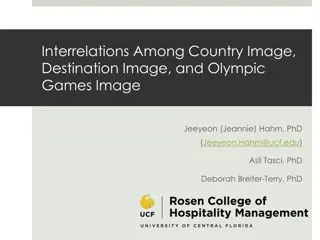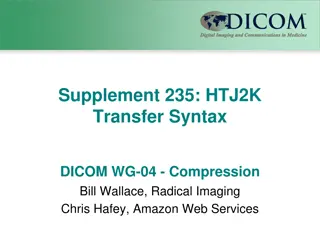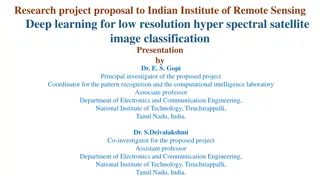Multi-Stage Transfer Learning System in Medical Image Classification
Transfer Learning is a deep learning technique that leverages pre-trained knowledge to improve learning in specific tasks. This study introduces a Multi-Stage Transfer Learning system with Lightweight architectures to address challenges like limited labeled data and computational costs in medical image classification. By utilizing transfer learning, this system aims to enhance performance even in data scarce scenarios by transferring knowledge effectively. Explore how lightweight architectures and transfer learning can optimize model performance in medical image analysis.
Download Presentation

Please find below an Image/Link to download the presentation.
The content on the website is provided AS IS for your information and personal use only. It may not be sold, licensed, or shared on other websites without obtaining consent from the author.If you encounter any issues during the download, it is possible that the publisher has removed the file from their server.
You are allowed to download the files provided on this website for personal or commercial use, subject to the condition that they are used lawfully. All files are the property of their respective owners.
The content on the website is provided AS IS for your information and personal use only. It may not be sold, licensed, or shared on other websites without obtaining consent from the author.
E N D
Presentation Transcript
Multi-Stage Transfer Learning System with Lightweight Architectures in Medical Image Classification RAJESH GODASU, OMAR EL-GAYAR, AND KRUTTIKA SUTRAVE
OUTLINE Introduction and research objectives Background and related works Convolutional Neural Networks and challenges Types of Transfer Learning Lightweight Convolution architectures DL in MIC Multi-Stage Transfer Learning System Datasets Experimental setup Results Discussion Questions?
Introduction Transfer Learning is a deep learning technique to transfer the knowledge learnt from pre-training to the specific problem. Deep Learning Networks require more labelled data for better learning as they have millions of parameters. It is difficult to find labelled data in many domains such as health care. Transfer Learning performs better even in data scare situations. For instance, it is easy for a cricketer to transform into a baseball player when compared with a person who did not play sports. This presentation mainly talks about image classification tasks, but before learning in-depth about Transfer Learning, let us get an understanding of Convolutional Neural Networks
Research objective In this study, we propose the Multi-Stage Transfer Learning system using Lightweight architectures to tackle the problem of insufficient labeled data and expensive computations of the classic architectures in MIC.
Understanding Convolutional Neural Networks The important components in this diagram to understand CNN are input images, feature maps, convolutions, subsampling/pooling and Fully Connected Layer.
CHALLENGES Overparameterization Many of the MIC studies based on TL uses variants of classic CNN architectures. CNNs are overparameterized in MIC to gain performance improvements. A recent study reported that standard deep CNNs move lesser when compared to lightweight models during the training process because of overparameterization. This challenge could lead to increase in training times and longer epochs because of inefficient learning. Expensive Computations A recent study uses extra modules for gaining discriminative features from the deep layers and to decline features that are not required, using these modules proved to improve the accuracy but increases the computational load. Usually, smaller training times and computational costs would benefit the MIC research. The inception network has 7 million parameters which are less when compared to other classic CNN s, but still higher for a regular i5 computer to train. There is a huge improvement in CPU s and GPU s in recent history, but it is not cost-effective at this time Insufficient Labelled Data Obtaining large amounts of labeled Medical image datasets is a difficult task. TL can further prosper and create more robust solutions with the availability of sufficient labeled data.TL methods perform well in the data-scarce conditions, but there is still room for further improvement. In natural images, the differences in features are significant from one image to another, but these differences can be minute in medical images making it difficult to learn while using TL method. The current popular method used to overcome this challenge is to use Multistage Transfer Learning
Types of Transfer Learning Feature extraction consists of using the representations learned by a previous network to extract interesting features from new samples. These features are then run through a new classifier, which is trained from scratch.
Types of Transfer Learning Fine-tuning consists of unfreezing a few of the top layers of a frozen model base used for feature extraction, and jointly training both the newly added part of the model (in this case, the fully connected classifier) and these top layers This is called fine-tuning because it slightly adjusts the more abstract representations of the model being reused, in order to make them more relevant for the problem at hand.
Lightweight Convolution architectures Lightweight CNN architectures are efficient neural networks trying to mimic the accuracies of traditional deep CNN s with lesser parameters. Training these architectures requires less time and also performs efficiently in distributed training cases across multiple servers as the number of parameters is less. Popular Lightweight architectures are MobileNet, ShuffleNet, NasNets, MobileNetV2 etc. We use MobileNet for our system among these efficient lightweight models. MobileNets use depth-wise separable convolutions and 1x1 convolutions to reduce the computations. The depth- wise separable convolutions are explained in Fig 1.
Related Work DL in MIC PlexusNet (Eminaga et al. 2019) is a CNN, designed for histologic image analysis that is nine times smaller than MobileNets In a recent study (R. Roslidar et al. 2019) compared four CNN models Resnet (He et al. 2016), Densenet(Huang et al. 2017), MobilenetV2 and ShuffleNetV2(Ma et al. 2018) for breast cancer classification task. ShuffleNetsV2 were trained quicker compared to other models. One of the first studies to implement two-stage TL in MIC is (Kim et al. 2017). Another study, (Ausawalaithong et al. 2018) used chest X-Ray14 (Wang et al. 2017) dataset in the first stage TL of Densenet architecture to learn the lung nodules information from the images, then retraining the architecture to actually classify lung cancer images.
Multi-Stage Transfer Learning System The system proposed in this study contains two stages of TL, each stage with different benefits. Before applying the first stage TL, a pre-trained MobileNet model is loaded. The MobileNet pre-trained on the ImageNet dataset with 1000 classes contains the key knowledge of general features of natural images useful in detecting the general identifiable patterns from medical images. Stage-1: The knowledge obtained from the ImageNet dataset is used in this stage by freezing the lower layers of the MobileNet architecture. In this stage, before applying TL, the new fully connected layers are added by eliminating the ImageNet fully connected layers. This is done to match the current problem. In this stage, the problem is to classify the Chest-Xray14 dataset for pneumonia and normal classes in order to let the machine adapt the domain shift. For TL, the fully connected layers along with few top-level convolution layers are retrained in this stage. Stage-2: CT-Head Images are classified in this stage for Hemorrhage and Normal cases, our target. In this stage, the ImageNet weights along with layers of stage 1 fine-tuned base are also frozen to preserve the knowledge of the stage of TL in order to transfer it in this stage. Again, the Fully- connected layers of Stage-1 TL are eliminated to add our own classifier in this stage. The new fully-connected along with top layers of stage-1 fine-tuned convolutional layers are retrained in this stage.
Data sets CT-Head: This public dataset from Kaggle( Head CT - Hemorrhage ) has 200 CT images. 100 of them are depicted hemorrhage while the remaining represent normal cases. This dataset is very small and hence it is the right choice as a target dataset for our approach to tackling the limited labeled datasets problem. Chest X-Ray: This publicly available dataset( Chest X-Ray Images (Pneumonia) ) contains 5,863 images representing the presence or absence of pneumonia and is obtained from Kaggle. This dataset is organized into train, test, and validation folders with two classes pneumonia and normal.
Experimental setup The multi-stage transfer learning concept is alleviating the problem of very small labeled datasets. Here we implement the ImageNet pretrained MobileNet fine-tuning in two stages. Stage 1: The ImageNet pretrained MobileNet is fine-tuned on the sample of Chest-Xray14 dataset to adapt the domain of medical images from natural images. The model learns the medical images features during this stage. We used a batch size of 16, Adam optimizer and 20 epochs in this stage. Stage 2: The weights learned in the stage 1 are used in the stage 2 for the binary classification of Hemorrhage and normal cases on CT Head dataset. Since the model already learnt the medical image similarities from stage 1, it improves the accuracy. We used a batch size of 8, Adam optimizer and 10 epochs in this stage as the dataset is very small.
Results For the preliminary study, the performance of the model in this study is evaluated using accuracy. The accuracy shows the degree to which the model detects both the classes, Hemorrhage and Normal in our case. Our Multi-Stage Transfer Learning system produces an accuracy of 87.5% which is improved when compared to the traditional single-stage TL which produced an accuracy of 75%. Transfer Learning Type Single Stage TL Multi Stage TL (our approach) 87.50 Accuracy 75.00
Discussion The preliminary results of the study are encouraging in terms of training and testing accuracy. Further, the specificity and sensitivity of the model needs to be which are considered important metrics in the Medical image classification The lightweight nature of MobileNet when used with TL successfully helps in reducing the training time because of the reduced number of parameters.
Conclusion and future research Preliminary results show that the combination of Multi-stage TL and lightweight architectures improved classification accuracy from 75 to 87.50 percent when compared to a traditional single-stage TL. Future work will aim to assess the generalization capabilities of the model using different target and bridge datasets. Also, to further improve classification performance we plan to experiment with increasing the number of stages for transfer learning and with using variants of MobileNet. We will also evaluate data enhancement techniques such as GAN models
This Photo by Unknown Author is licensed under CC BY-NC-ND This Photo by Unknown Author is licensed under CC BY-NC-ND
